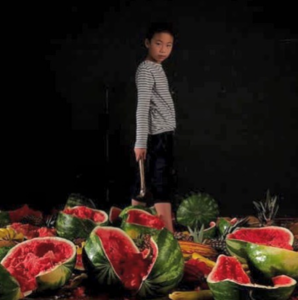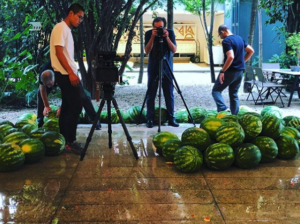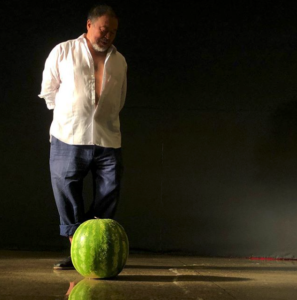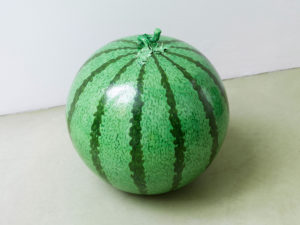For almost a year, I have been devoting my energies towards posting a picture a day of some food-themed artwork on my Instagram account, usually with a sentence or two of explanation. The intention has been to start expanding upon my discoveries here, on the blog, leading up to the release of my second book, A Feast for the Eyes, in June of 2019. Just this very morning, I reposted this picture from Ai Weiwei’s Instagram account: A steely black background  in which a young Chinese boy is standing – seemingly wielding the hammer and the perpetrator of the shattered gourds – looking directly at the camera. The fleshy vibrant red of the watermelon immediately invokes blood, as though the young child is standing in the midst of a slaughterhouse. But is he surveying the destruction he, himself, has wrought? When I shared the post on Facebook, I admitted that all I knew about the image was that it was recently staged in São Paulo, Brazil by Ai Weiwei. I’m apologized that I didn’t know the title, but explained that much of Weiwei’s current IG feed has been full of videos of people reading excerpts of a book on human rights, and assumed there is a connection I had yet to make. A striking image nonetheless. Most of Ai Weiwei’s work has to do with human rights in some fashion.
in which a young Chinese boy is standing – seemingly wielding the hammer and the perpetrator of the shattered gourds – looking directly at the camera. The fleshy vibrant red of the watermelon immediately invokes blood, as though the young child is standing in the midst of a slaughterhouse. But is he surveying the destruction he, himself, has wrought? When I shared the post on Facebook, I admitted that all I knew about the image was that it was recently staged in São Paulo, Brazil by Ai Weiwei. I’m apologized that I didn’t know the title, but explained that much of Weiwei’s current IG feed has been full of videos of people reading excerpts of a book on human rights, and assumed there is a connection I had yet to make. A striking image nonetheless. Most of Ai Weiwei’s work has to do with human rights in some fashion.
Two additional images were posted on his IG page that I didn’t share; a work-in-progress image of the melons before their destruction and an equally striking image of the artist himself, standing next to a single watermelon. I was almost tempted to post the latter as part of my recurring series. But a little research showed me that in 2006, Weiwei was creating watermelons in porcelain, so I am unsure if the one sitting at his feet in this image is a real melon or one of his creations. I am tending towards the former, but it is interesting to me that he has gone back to utilize similar themes from his past in a different context.



But an old friend sent me a private message to explain the symbolism to me and it has haunted me all day… “The melons represent the skulls of Chinese minority groups..very much and quietly persecuted in China.” In many ways, Ai Weiwei’s activism in presenting human rights atrocities through art is more startling and harrowing than the true images or stories, partly because he has been subjected to the tyrannies of his own government and knows the violations firsthand. I have been fortunate to see several of his pieces in person; notably Interlacing at the Jeu de Paume in Paris, 2012 and the @Large: Ai Weiwei on Alcatraz – FORSITE Foundation in 2015.
What I wished I had experienced in person was the 2008 Tate Modern installation of Weiwei’s sunflower seeds. Viewers in the museum were originally able to interact and walk across the sunflower seeds, but after the Tate Modern Museum recognized that the dust emitting from the installation was harmful to viewers lungs, they fenced it off. The piece has been exhibited in twelve exhibitions from 2009-2013 in museums and galleries across the world.
This massive art installation included over 100 million porcelain sunflower seeds that covered a 1,000 square meter floor with a depth of 10cm in the Tate Modern’s Turbine Hall. The entire artwork weighed around 150 tons. Each seed went through a 30-step procedure, hand painted and fired at 1,300 degrees. This process required more than 1,600 workers over a span of two and a half years in Jingdezhen, a town that is known as the “Porcelain Capital,” and has produced the imperial porcelain for over a thousand years.
Sunflower seeds were a common theme in the Chinese Communist Party’s political propaganda during Weiwei’s childhood. Leader Mao Zedong would often represent himself as the sun, and the people of China as seeds on sunflowers in artworks. Weiwei also explains that when he was growing up, even the poorest families in China could share the seeds as a treat. Although I did not get to see it, I have been able to purchase some of the porcelain seeds which I keep in a long tray, immediately below my monitor.
The seeds represent optimism during difficult times.